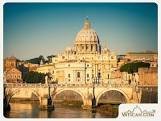St. Peter's Basilica is one of the most iconic and impressive Catholic churches in the entire world, but how did such a massive structure come to be? It all started in the 1440's and 1450's under Pope Nicholas V. At the time, there was another St. Peter's Basilica located in Rome, referred to as 'Old St. Peter's Basilica.' The original basilica was built in the early 300's A.D. on the site where St. Peter was martyred in Rome. Pope Nicholas V took a look at the original structure and decided it was time to spruce up the crumbling building. Early plans for the new basilica began in 1452 under the architect Bernardo Rosselino.
Unfortunately for Nicholas V and Rosselino, neither lived to see the beginning of construction. Pope Paul II broke ground on April 18, 1506 using Donato Bramante's blueprints. Architect Giuliano da Sangallo envisioned a large church in the shape of a cross with an altar set at the center of the cross. Along with Giuliano da Sangallo, famous artists and architects Raphael and Friar Giovanni Giocondo worked on the project as well. In the years following, direction of the New St. Peter's basilica would fall to Antonio da Sangallo the Elder, Andrea Sansovino, and Baldassarre Peruzzi. In 1527, Antonio da Sangallo the Younger became the chief architect. Who knew building a church required so many changing of hands?
(The Early Years)
To better understand this, it's important to remember what life was like in the 1500's. Often, the common cold or infection from a paper cut were enough to kill, so the turnover of architects on the new basilica was high. After Antonio da Sangallo the Younger's passing, the renowned Michelangelo took over the project and oversaw construction for 18 years from 1546 to 1564. During that time, Michelangelo designed a massive dome that would sit in the middle of the cross above the altar. At its highest point, the dome reaches over 445 ft. from floor to ceiling. When Michelangelo died at the age of 89, the dome was mostly complete, but it would be another 16 years until his student Giacomo Della Porta would finish it entirely.
Between 1564 and 1605, architects Giacomo Vignola and Giacomo Della Porta finished the dome, added a massive lantern to the center of the church, and tore down the remains of the Old St. Peter's Basilica. From 1608 to 1612, Carlo Maderno worked to design and build the basilica's atrium, or open portico, and eventually began work on the exterior of the church. After over 100 years of construction, the New St. Peter's Basilica was officially consecrated, or declared sacred by the church, in 1626.
(The Late Years)
Size-Materials and Artwork
St. Peter's Basilica is a massive church that can fit up to 22,000 people at one time. The church is over 600 feet long (equal to two football fields!) and 190 feet wide. The nave, or main part of the church, is almost 150 feet high, and the altar at the center of the church is approximately 95 feet tall. Despite its humongous size, St. Peter's Basilica is only the second-largest Christian church in the world. The largest, the Basilica of Our Lady of Peace, is located in Cote d'Ivoire and was finished in 1989.

Hi! I am a robot. I just upvoted you! I found similar content that readers might be interested in:
https://study.com/academy/lesson/st-peters-basilica-in-rome-architecture-history-quiz.html
@steemcleaners